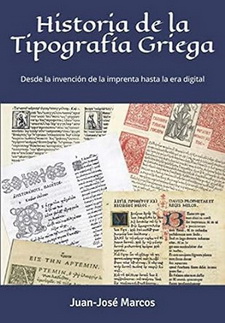|
HISTORY
OF GREEK TYPOGRAPHY:
From the invention of printing to the Digital Age |

Professor of classical languages.
Plasencia. Spain. January 2025.
DESCRIPTION
The book explores every major development in the design of Greek type and includes some lesser-known designers whose type designs made significant contributions to the craft. The material is divided into sections by historical period for easy reference.
The text of the book provides an excellent historical background to the study of Greek printing types.
“History of Greek Typography" stands a step above other books on the history of Greek printing types because of the number of its reproductions -some of them extremely rare- and its straightforward and clear exposition.
This work, profusely illustrated, not only addresses the Hellenic scholar, but also the modern writer, typographer, historian, graphic designer, printer, publisher and font developer.
TABLE OF CONTENTS
Introduction.
1. From handwriting
to type.
11. Johann
Froben of Basel and Erasmus of Rotterdam. The New
Testament in Greek.
12. The beginnings of Greek typography in France: Guilles de
Gourmont, Badius Ascensius and Simon de Colines.
13. The French Royal Greek types: Neobar, Claude
Garamont and the Estienne family.
14. The followers of Garamont: Haultin, Granjon, Le Bé
and Jannon.
15. Christophe Plantin and the “Biblia Regia”.
16. The Elzevirs: the pocket book.
17. Greek types in England. XVI-XVII centuries: Savile, Walton and Fell.
18. The Golden Age of Greek typography in Netherlands.
The
first steps towards a Greek type without ligatures.
19. The Transitional period: Caslon, Baskerville, Martin, Fournier and Ibarra.
20. The
Foulis brothers and Alexander Wilson.
The end of the ligatured Greek.
21. The Modern types: Bodoni and Didot.
22. The
English contribution: Porson, Watts, Hibbert and Selwyn.
23. Greek
types in Germany: Georg Joachim Goschen.
24. Greek
types from the Second Industrial Revolution to the beginning of the
Digital Age.
25. Greek types in the classical collections: Teubner,
Oxford, Budé and Loeb.
26. Greek digital typefaces. Revivals of classical
types.
LOOK INSIDE THE
BOOK / EXCERPTS OF THE BOOK IN PDF FORMAT
ORDER A PRINTED COPY
This book is printed via "Print On Demand" (POD) by CreateSpace; it is printed in South Carolina (United States), United Kingdom and continental Europe (it depends on through what channel it is ordered). The characteristics of POD are well known: the book is immediately produced (printed, bound and sent within some hours) as soon as the buyer orders it. Obviously, the number of days needed to reach its destiny will depend on the country to which the purchaser wants it to be sent and the chosen shipping option (urgent post, normal post, etc.).
Price and distribution
The range of channels through which a POD company can distribute a book is the result of the combination of several factors (industry standard trim or personal trim, property of the ISBN by the author or by the printer, etc.). In this case, the book can be purchased either directly from the printer itself KDP AMAZON) https://www.amazon.es/dp/B091DWJ184 or other booksellers.
Buying a book through Amazon or Barnes & Noble is nothing unusual nowadays, and I do not believe that this would pose any difficulty to anybody.
The price is 29 US Dollars, and in the sites of continental Europe it is around 26 Euros.
While the price in American Dollars and in British Pounds seems to be kept without changes by the British and American sites of Amazon, I have observed that the Amazon sites of continental Europe have set different prices; I have no control on this. The prices mentioned above are the prices I suggest to CreateSpace, but the different sites of Amazon (each Amazon national site has absolute independence in this respect) can either keep it as I suggest or put it higher or lower.
If you wish to acquire this book in electronic format (available in PDF), please contact the author for details and price.
ABOUT THE AUTHOR
Juan-José Marcos is a font developer too. He has created the ALPHABETUM Unicode font for ancient scripts https://www.typofonts.com/alphaeng.html and other digital typefaces for Latin and Greek palaeography https://www.typofonts.com/palegreek.html
Juan-José Marcos
Plasencia (Cáceres) Spain.
This page last updated on January 2025